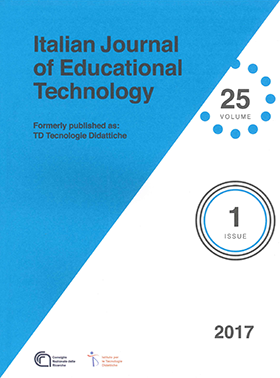Speech analysis technology and Italian L2 literacy. The case of adult Senegalese immigrants
Main Article Content
Abstract
A training experience that takes advantage of technologies for acoustic analysis in order to taylor the learning experience on learners abilities and learning style.
Article Details
Section
Authors who publish with this journal agree to the following terms:
- Authors retain copyright and grant the journal right of first publication with the work simultaneously licensed under a Creative Commons CC BY 4.0 Attribution 4.0 International License.
- Authors are able to enter into separate, additional contractual arrangements for the non-exclusive distribution of the journal's published version of the work (e.g., post it to an institutional repository or publish it in a book), with an acknowledgement of its initial publication in this journal.
- Authors are permitted and encouraged to post their work online (e.g., in institutional repositories or on their website) prior to and during the submission process, as it can lead to productive exchanges, as well as earlier and greater citation of published work (See The Effect of Open Access)
References
Balboni, P. E. (2002). Le sfide di Babele. Insegnare le lingue nelle società complesse. Torino, Italy: UTET.
Bigelow, M., & Tarone, E. (2004). The role of literacy level in SLA: Doesn’t who we study determine what we know?. TESOL Quarterly, 38(4), 689-700.
Condelli, L., Wrigley, H. S., Yoon, K., Seburn, M. & Cronen, S. (2003). What works study for adult ESL literacy students. Washington, DC: US Department of Education.
Consiglio d’Europa (2002). Quadro comune europeo di riferimento per le lingue: apprendimento, insegnamento, valutazione. Milano, Italy: R. C. S. Scuola, La Nuova Italia.
Kurvers, J. J. H,. & Stockmann, W. (2009). Wat werkt in Alfabetisering NT2. Leerlast en succesfactoren [Focus on L2 literacy: Study load and success factors]. Tilburg, The Netherlands: Universiteit van Tilburg.
Maffia, M. (2015). Intonazione, ritmo e atti linguistici. L’italiano L2 di apprendenti senegalesi con diversi modelli di literacy. In M. Chini (Eds.), Il parlato in [italiano] L2: aspetti pragmatici e prosodici (pp. 38-58). Milano, Italy: FrancoAngeli.
Maffia, M., Pettorino, M., & De Meo, A. (2015). To mumble or not to mumble. Articulatory accuracy and syllable duration in L2 Italian of Senegalese learners. In D. Russo (Ed.), The Notion of Syllable across History, Theories and Analysis (pp. 354-371). Newcastle Upon Tyne, United Kingdom: Cambridge Scholar Publishing.
Rocca, L., Grego Bolli, G., Minuz, F., Borri, A., & Sola, C. (2014). Italiano L2 in contesti migratori. Sillabo e descrittori dall’alfabetizzazione all’A1. I Quaderni della Ricerca, 17. Torino, Italy: Loescher.

